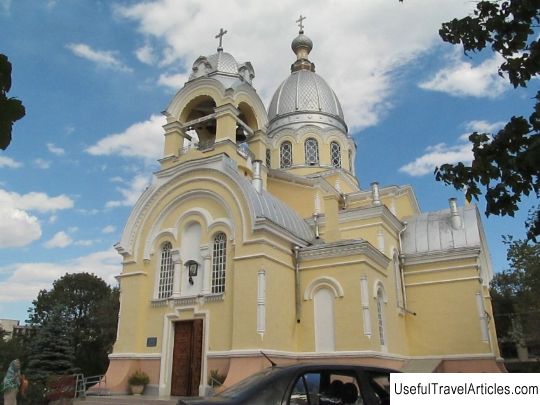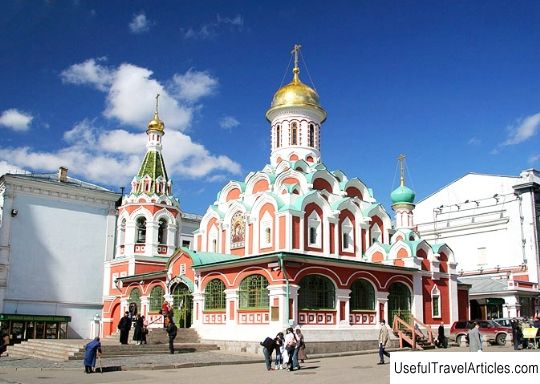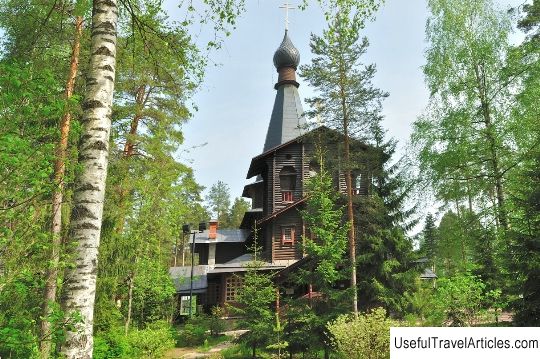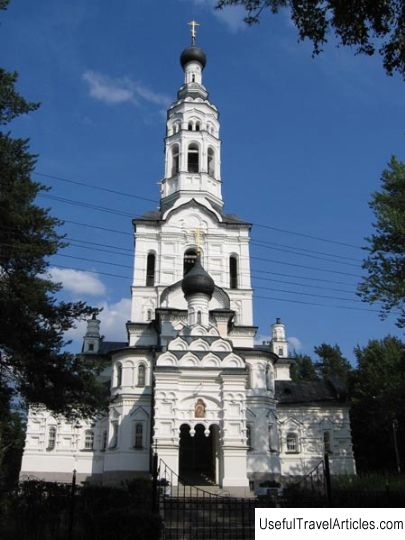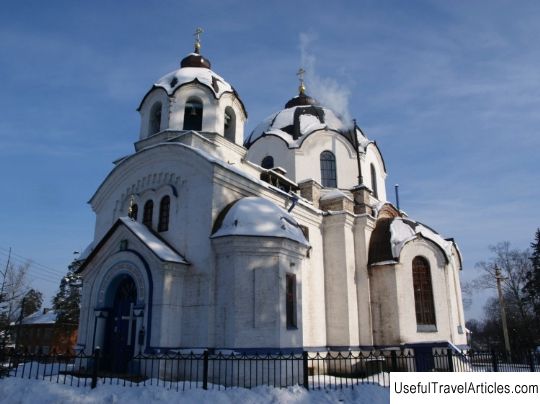Kazan Cathedral description and photos - Russia - St. Petersburg: St. Petersburg
Rating: 9,7/10 (8795 votes) 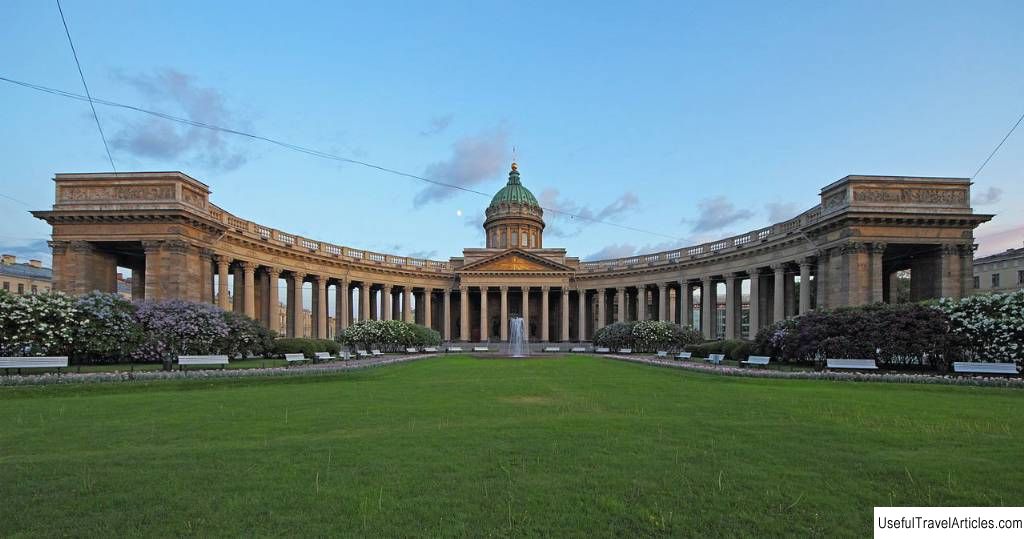
Kazan Cathedral description and photos - Russia - Saint Petersburg: Saint Petersburg. Detailed information about the attraction. Description, photos and a map showing the nearest significant objects. Photo and descriptionOne of the most famous sights of St. Petersburg is the majestic Kazan Cathedral (another name of the temple is Cathedral of the Kazan Icon of the Mother of God ). It was built at the beginning of the 19th century. The temple was consecrated in honor of the highly revered image, for the sake of which the magnificent building was erected. The shrine is in the church to this day: this is a list of one of the most famous icons - the image of the Kazan Mother of God. Soon after the construction was completed, a war broke out between the French and Russian empires, after which the temple began to be perceived as a monument to the glory of the Russian army. Here you can see military trophies from that period. On the territory of the temple there is the grave of the famous military leader Mikhail Kutuzov. Three centuries of the history of the templeBefore the Kazan Cathedral was built, the list of the miraculous icon was kept in the church consecrated in honor of the Nativity of the Virgin. This church was built in the 30s of the 18th century, and by the end of the named century it was dilapidated. Then it was decided to build a new temple in its place. A competition was announced by the emperor, famous architects presented their projects, but none of them won. After some time, the emperor was offered another project, the author of which was the former serf Andrei Voronikhin . This project was approved by the Emperor. Construction work continued ten years (very short term, considering the technology of the 19th century!). The cost of these works exceeded four and a half million rubles. The old church, which contained the list of the miraculous image, was dismantled only after the construction of the new temple was completed. The finishing work on the building continued until the end of the 20s of the XIX century . They ended almost eighteen years after the consecration of the cathedral. In the 40s of the XIX century, the temple was renovated for the first time. A second renovation was carried out almost twenty years later. It included the restoration of wall paintings and the restoration of icons. Student demonstrations were held on the square in front of the cathedral. In the same place, in the mid-70s of the 19th century, a demonstration of one of the revolutionary societies took place. At the beginning of the 20th century, a solemn event took place in the temple - the celebration of the three hundredth anniversary of the Romanov dynasty . But this page of the history of the temple cannot be called joyful: during the celebrations in the overcrowded cathedral, a terrible crush began, in which several dozen people died. In the post-revolutionary period, or rather, in the 20s of the XX century, from the temple many valuables were seized, its interiors were badly damaged. In particular, the unique iconostasis made of trophy silver was destroyed. He was sent to be melted down. In total, approximately two tons of silver were removed from the cathedral (not counting many other valuables). In the early 30s of the XX century, the temple was closed, and after a short time a museum opened in its building, the expositions of which were devoted to the history of religion and atheism. In the middle of the 20th century, restoration work was carried out in the building. First, the interiors were carefully restored, then the facades. In the early 90s, services were resumed in one of the side-chapels of the cathedral . A few years later, the cross shone again over the dome of the temple. At the end of the 90s, the building was completely consecrated. At the beginning of the 21st century, it was finally returned to the Russian Orthodox Church. The interiors of the temple and its architecture Before the construction of the cathedral began, the emperor expressed the following wish: the temple should resemble a Roman cathedral consecrated in honor of St. Peter. This wish was fulfilled: the colonnade of the Kazan Cathedral really resembles the columns of the famous Vatican temple. The Colonnade of the St. Petersburg Cathedral consists of ninety-six columns . In addition to giving the temple a resemblance to an Italian cathedral, she also allowed the architect to solve one difficult problem. The fact is that in Orthodox churches, the entrance is traditionally located in the western part of the building, and the altar in the eastern; the avenue on which the cathedral was built stretched from west to east. For this reason, the temple actually stands sideways to the avenue, but this is imperceptible thanks to the columns that adorn the northern (that is, the side) part of the church. By the way, the architect planned to decorate the temple with exactly the same columns from the south side, but for a number of reasons he failed to complete his plan. The dome of the cathedral is almost eighteen meters in diameter . It is formed by two rows of ribs made of iron. And under a huge iron dome there are two more, these domes are built of bricks. Interestingly, all of these domes were built even before methods of static analysis of such structures appeared. We can say that intuition helped the architect to successfully design the domes. The walls of the cathedral are faced with a special tuff , mined in the Gatchina region. Pedestals have been preserved on both sides of the giant colonnade. Once upon a time there were sculptures depicting angels. They were made of plaster and, according to the plan of the builders, they were to be replaced by similar bronze statues. But these plans never materialized. In the 20s of the XIX century, the plaster sculptures were removed, but for a number of reasons the installation of new ones was not made. Tourists are impressed by the facades of the cathedral, but its interiors are not disappointing either. The temple has more than fifty columns . They are made of pink granite and are decorated with gilded capitals. Visitors are also impressed by the bas-reliefs of the early 19th century. The images of the temple were painted by famous painters of the same period of time. Speaking about the images, one cannot fail to mention the most important shrine of the temple. It is, as mentioned above, a list of the famous miraculous icon, in whose honor the cathedral was consecrated. Sculpture and painting The cathedral contains many fine works of art; which of them should you pay the most attention to? Which ones to look first? Let's name some of these works: - Both inside and outside the temple is decorated with many sculptures . All of them deserve close attention, as they were created by the best sculptors of the country. - Pay attention to the bronze northern doors of the temple . They were made by the foundry master Vasily Yekimov, famous in the 19th century. These doors are an exact copy of the doors cast in the 15th century by the sculptor Lorenzo Ghiberti for the Florentine baptismal house. - Separately, a few words should be said about painting. The iconostasis of the temple, its pylons and walls were painted by famous artists of the early 19th century. Among them are Karl Bryullov, Fyodor Bruni, Pyotr Basin and many others. - Pay special attention to the painting " The Taking of the Virgin into Heaven ". This is an altarpiece, its author is Karl Bryullov. According to experts, this work is one of the main adornments of the cathedral, although the rest of the paintings in the temple are certainly worthy of a careful examination. Monument of military glory As it was said above, the temple is a kind of monument to Russian military valor , the victory over the French Empire. Here, after the end of the war with Napoleon's army, enemy banners captured by the victors were displayed. There were one hundred and seven such banners (currently most of them are in the Russian capital). And next to them, ninety-seven keys could be seen. These are the keys to the cities that surrendered to the Russian army. Most of these trophies are also currently in Moscow. Six sets of keys can be seen in the St. Petersburg church, they are located above the grave of Mikhail Kutuzov (the great military leader was buried on the territory of the cathedral). By the way, there is a misconception that the heart of the famous Russian the commander was buried separately from his body, in one of the Polish cities. But this version is not true. In the first half of the 20th century, an autopsy was carried out on the body of the commander. The results of this autopsy completely debunked the version of a separate burial of the heart. In the 30s of the XIX century, monuments to the famous Russian military leaders were unveiled on the square in front of the temple. The monuments were cast in bronze. Interesting factsIn the second half of the 19th century, a rather critical attitude to the architecture of the famous cathedral was widespread, since at that time interest in classicism was lost, and copying - even partial - Western designs were considered unacceptable. But at the beginning of the 20th century, tastes changed, interest in classicism returned and the cathedral again began to arouse general admiration. In the 21st century, a special coin depicting the famous St. Petersburg church was issued. This twenty-five-ruble coin was made of nine hundred and twenty-fifth silver. The circulation of the coin was one and a half thousand copies. Its weight is one hundred fifty-five and a half grams. Notes
                   We also recommend reading St. John's Church (Rigas Sveta Jana baznica) description and photos - Latvia: Riga Topic: Kazan Cathedral description and photos - Russia - St. Petersburg: St. Petersburg. |
